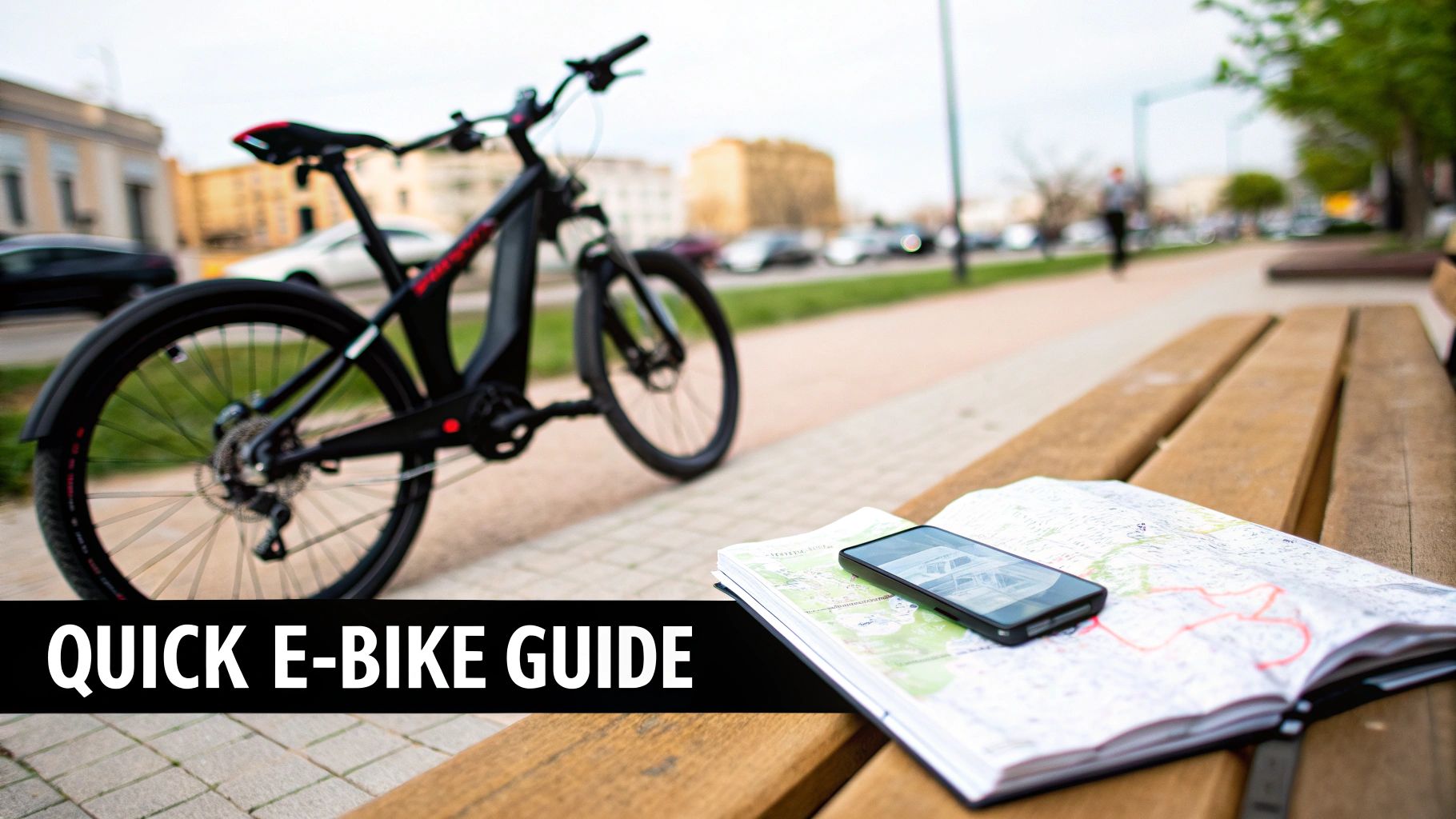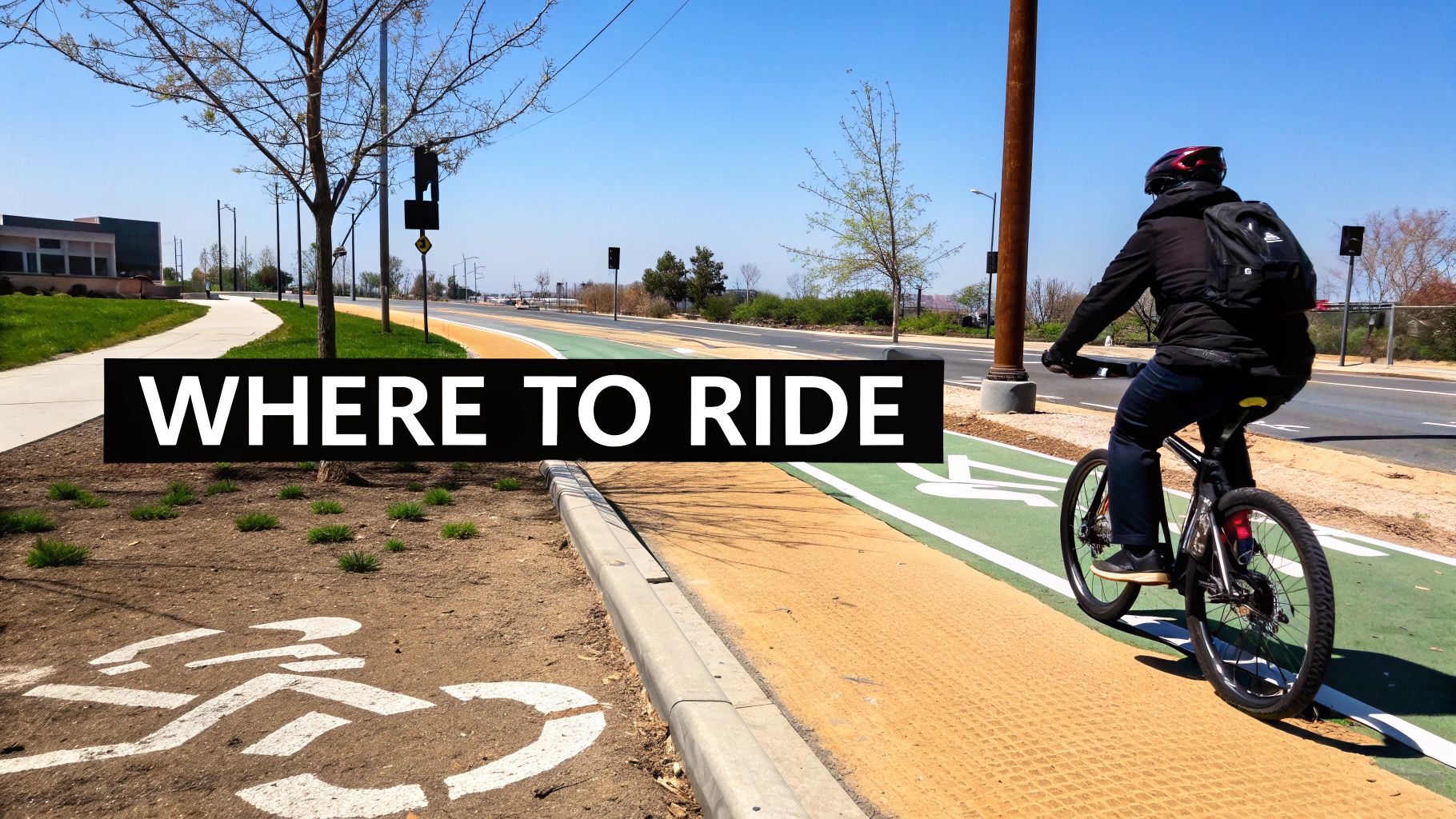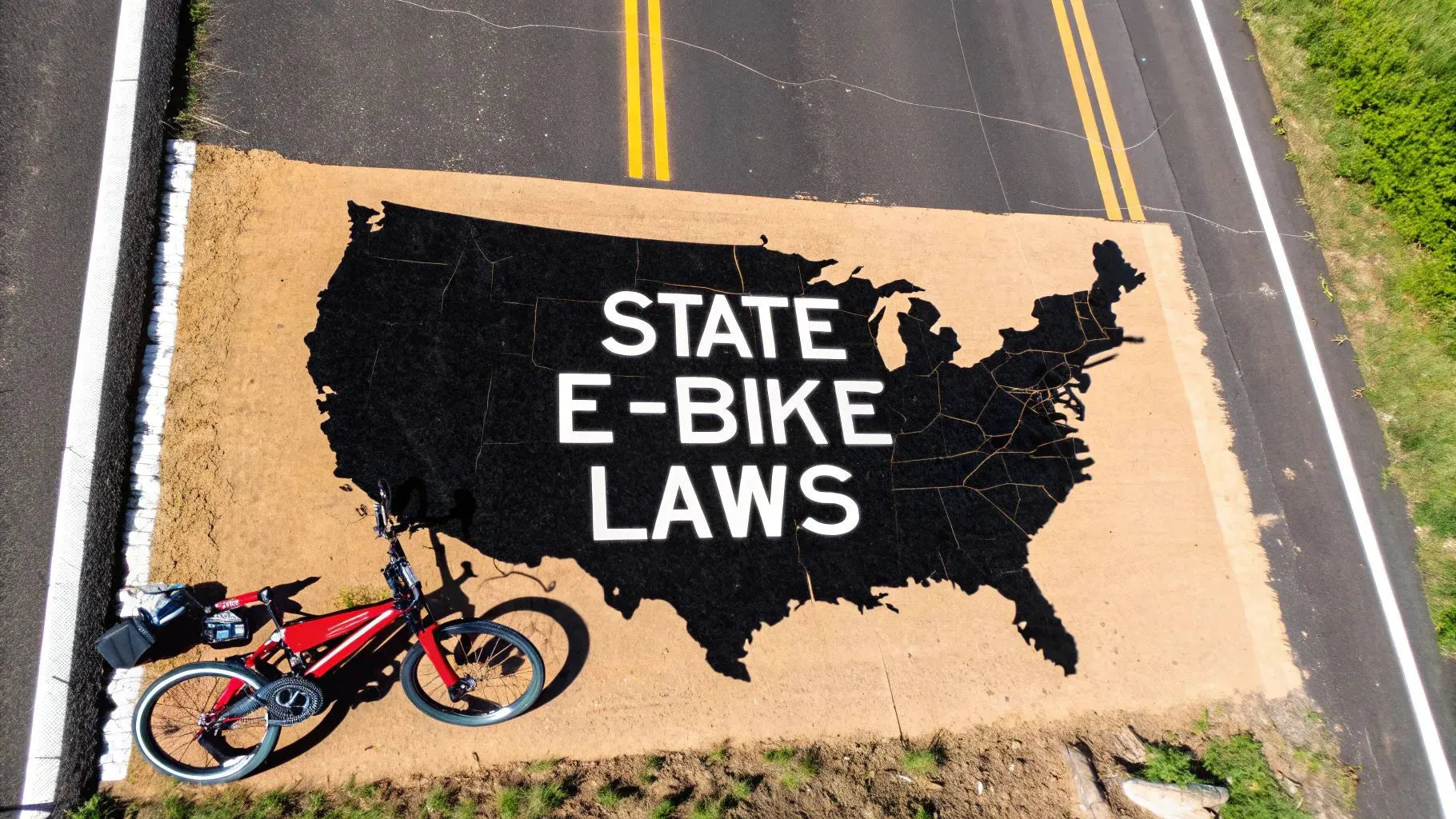Figuring out the e-bike laws in your state can feel like a headache, but it’s actually more straightforward than you might think. It all boils down to a three-class system that most states have adopted. This system sorts e-bikes based on how they give you a boost and how fast they can go with that help.
Once you know your e-bike’s class, you’ll know exactly where you can ride and what rules you need to follow.
Quick Guide to US E-Bike Laws and Classifications

As e-bikes have exploded in popularity for everything from daily commutes to weekend adventures, states have scrambled to keep up. Thankfully, most have landed on a pretty logical three-class system. This setup helps separate e-bikes from more powerful vehicles like mopeds and motorcycles, which usually come with the hassle of licenses and registration.
The whole point is to create some consistency so you don't have to learn a new set of rules every time you cross a state line. This guide is your one-stop shop for breaking down those rules, state by state. Just figure out your e-bike's class, and you'll be set to check the rules on speed limits, age requirements, and where you're allowed to ride.
Your E-Bike Class Explained
The three-class system is the cornerstone of almost all electric bike laws by state. Seriously, if you know your bike’s class, you’re 90% of the way to riding legally and confidently.
Here’s the breakdown:
- Class 1: This bike only gives you a boost when you’re actively pedaling, and that help cuts out once you hit 20 mph. Think of it as having superhuman legs.
- Class 2: This one’s got a throttle, meaning you can get a push without pedaling at all. Just like Class 1, the motor assistance stops at 20 mph.
- Class 3: Back to pedal-assist only (no throttle here!), but this one keeps helping you up to a zippier 28 mph. It’s built for speedier commutes.
Most of the time, you can find a sticker right on your e-bike’s frame from the manufacturer that tells you its classification. That little label is your golden ticket. For example, a Punk Ride model like the HITWAY BK15 is a Class 2 e-bike. On the other hand, a speedier model like the CYSUM CM980 would be considered Class 3. This distinction really matters, especially when it comes to trail access in states like California or Colorado.
E-Bike Classifications At a Glance
To make it even simpler, here's a quick cheat sheet. This table breaks down the three classes so you can easily pinpoint where your bike fits. Keep this in mind as you dive into the specific electric bike laws by state later on.
| E-Bike Class | Assistance Type | Max Assisted Speed | Typical Use Case |
|---|---|---|---|
| Class 1 | Pedal-Assist Only | 20 mph | Bike paths, commuter lanes, and multi-use trails |
| Class 2 | Throttle-Assist (and Pedal-Assist) | 20 mph | Urban commuting, errands, and leisurely rides |
| Class 3 | Pedal-Assist Only | 28 mph | Road commuting and high-speed fitness riding |
Having this handy will make navigating the state-specific rules we're about to get into a total breeze.
Understanding the Three-Class System for E-Bikes

When you dig into electric bike laws by state, you’ll see one concept pop up again and again: the three-class system. Think of it as the bedrock for most e-bike regulations in the U.S. It was designed to bring some much-needed order to the e-bike world, creating a straightforward way to define what an e-bike is based on its speed and how the motor works.
Knowing your bike's class isn't just trivia—it's the key to riding legally. It tells you where you can ride, if you need a helmet, and whether any age limits apply. Luckily, manufacturers make this easy. Just look for a sticker on your bike's frame; that little label tells you everything you need to know to follow the local rules of the road.
This system has caught on in a big way. As of 2024, a whopping 44 states have officially adopted this classification model, making it the go-to framework for lawmakers across the country.
The Three Classes Decoded
Each class provides a totally different riding experience, and the laws treat them differently because of it. The whole thing boils down to whether you have to pedal for the motor to work (pedal-assist) or if you have a throttle, and how fast the motor will help you go.
Let’s break them down.
-
Class 1: Pedal-Assist up to 20 mph
This is your classic e-bike experience. The motor gives you a boost, but only when you’re pedaling. Hit 20 mph, and the motor assistance gracefully cuts out, leaving the rest of the work to you. Since they feel and operate so much like a regular bicycle, Class 1 e-bikes face the fewest restrictions. You’ll often find them welcome on bike lanes and multi-use paths. For a deeper look, check out our guide on what is a Class 1 e-bike. -
Class 2: Throttle-Assist up to 20 mph
The game-changer for Class 2 is the throttle. You can get power on-demand without even pedaling, kind of like a moped or scooter. Just twist and go. The motor, whether you're using the throttle or pedal-assist, stops helping at 20 mph. That instant power is awesome for getting a jump on traffic at a stoplight or just cruising when your legs need a break.
Key Takeaway: The only real difference between a Class 1 and a Class 2 is the throttle. They both top out at 20 mph, but that throttle means some areas have slightly different rules for Class 2 bikes.
Understanding Class 3 E-Bikes
Often called "speed pedelecs," Class 3 e-bikes are built for getting places faster. They are pedal-assist only—no throttles allowed here—but the motor keeps helping you all the way up to 28 mph.
Because of that extra speed, Class 3 bikes come with the tightest regulations. It's common for them to be banned from multi-use paths where they'd be sharing space with pedestrians. You'll also see stricter helmet rules and higher minimum age requirements to keep everyone safe. Before you take a Class 3 out on a trail or path, you absolutely have to check the local ordinances.
How Motor Power Limits Vary By State
So, we've talked about the class system, but there's another big number you need to know: your motor's wattage (W). The federal definition for consumer e-bikes tops out at 750W, and that's the number you'll see most often. But—and this is a big but—states have the final say on what's legal on their roads.
This isn't just a technical detail. The wattage of your motor can be the difference between your ride being classified as a simple bicycle or an illegal motor vehicle. One mile over a state line, your perfectly legal e-bike could suddenly require a license and registration. That's why you absolutely have to know the local rules.
The 750W National Standard
Most states that use the three-class system also go with the 750W motor cap. This makes things pretty simple for riders across a huge chunk of the country. If your e-bike motor is 750W or less, you're probably in the clear, as long as you're also following the speed rules for your bike's class.
Why 750 watts? It's kind of the sweet spot. It gives you enough juice to flatten hills and haul some gear without being so powerful that it starts acting more like a moped. Most manufacturers, including us here at Punk Ride, build their main models around this 750W benchmark so they're legal in as many places as possible.
States With Different Wattage Rules
Of course, not every state plays by the same rules. Some are a bit more generous, while others tighten the leash.
Six states actually let you have a more powerful motor, bumping the limit up to 1000 watts. These are:
- Georgia
- Kansas
- Minnesota
- Oklahoma
- Oregon
- Virginia
On the flip side, Maryland is much stricter, capping motors at just 500 watts. The vast majority of other states stick to that familiar 750-watt maximum. For a full breakdown, you can dive into our complete guide to state-by-state e-bike regulations.
These differences matter. A beefy 1000W e-bike that’s perfect for the steep hills in Oregon would get you in trouble in California, where the law says 750W is the max. It’s all about where you ride.
Rider Tip: Check your motor! The wattage is almost always printed right on the motor casing or listed in your owner's manual. If you're planning a trip, a quick search for the electric bike laws by state for your destination can save you a world of hurt. A little homework now means no fines or confiscated bikes later.
Your Comprehensive State-By-State Reference Guide
Trying to untangle the web of electric bike laws by state can feel like a real headache, but we've put this guide together to make it simple. Here, we'll break down the must-know rules for all 50 states in an easy-to-read format. It doesn't matter if you're cruising down a California boardwalk or a country road in Maine—you’ll find exactly what you need to ride legally and safely.
Think of this as your go-to reference. Each state entry covers the essentials: the e-bike classification system they use, speed and motor limits, helmet and age requirements, and where you're actually allowed to ride. Bookmark this page, because you'll want to come back to it anytime you're riding somewhere new.
How To Use This Guide
We've organized the states alphabetically to keep things simple. For each one, you’ll find a quick-and-dirty summary of the most important regulations you need to know.
- Classification System: Does the state use the common three-class system, or do they have their own unique way of defining an e-bike?
- Speed and Motor Limits: We'll lay out the maximum assisted speed and the legal motor wattage.
- Helmets and Age: Find out if you need a helmet and if there are any age restrictions for riders.
- Licensing and Registration: Learn whether your e-bike needs a driver's license, plates, or insurance. Spoiler: it usually doesn't.
- Where to Ride: This is a big one. We'll clarify where you can take your e-bike, covering bike paths, roads, and sidewalks.
To give you a bird's-eye view, this chart shows the most common motor power limits across the country. It’s a great way to quickly see how things stack up.

As you can see, 750W is pretty much the gold standard across the U.S. But there are definitely outliers. Maryland, for instance, has a stricter 500W cap, while a few other states are more laid-back with a 1000W limit.
State-By-State Electric Bike Laws
Alright, let's get into the nitty-gritty for some of the most popular states for e-biking. One crucial tip: local city or park rules can always add another layer of regulations, so it's smart to do a quick search for local ordinances before you head out.
California
No surprise here, California is a leader in e-bike laws and fully embraces the three-class system. This makes it really clear for riders to know what's what.
- Classification: Adopts the standard Class 1, 2, and 3 system.
- Helmet Law: Helmets are mandatory for all Class 3 riders, no matter their age. For Class 1 and 2, helmets are required for anyone under 18.
- Minimum Age: You have to be at least 16 years old to ride a Class 3 e-bike. There's no minimum age for Class 1 or 2.
- Bike Path Access: Class 1 and 2 e-bikes are good to go on most paved bike paths. Class 3 bikes, on the other hand, are typically restricted from these paths unless a local rule specifically allows them.
Rider Insight: A recent update, California's AB-1909, gives local authorities the power to allow Class 3 e-bikes on certain multi-use trails. So, it definitely pays to check the local park websites for the latest rules.
Florida
The Sunshine State has made a real effort to simplify its e-bike laws, making it a very welcoming place to ride. Florida officially uses the three-class system, which puts it in line with most other states.
- Classification: Follows the three-class model.
- Helmet Law: Helmets are required for all riders and passengers under the age of 16.
- Minimum Age: You must be at least 16 to operate an e-bike on public roads or paths.
- Where to Ride: Generally, if a regular bike can go there, so can your e-bike. This includes streets, bike lanes, and multi-use paths.
Want to go deeper on Florida's rules? Check out our complete guide covering the specifics of electric bike laws in Florida.
Texas
Texas keeps things pretty straightforward by treating e-bikes almost exactly like traditional bicycles. This common-sense approach makes it easy for riders to know the rules of the road.
- Classification: Adopts the three-class system.
- Helmet Law: There's no statewide helmet law, but individual cities can make their own rules. Still, wearing one is always a good idea.
- Minimum Age: You have to be at least 15 years old to ride an e-bike in Texas.
- Licensing and Registration: Forget about it. No license, registration, or insurance is needed.
New York
New York has some very specific rules that draw a clear line between e-bikes and other gadgets like e-scooters. The state officially got on board with the three-class system back in 2020.
- Classification: Uses the three-class system.
- Helmet Law: Helmets are mandatory for all Class 3 riders and for anyone under 14, no matter what class of e-bike they're on.
- Minimum Age: You need to be at least 16 to ride any class of e-bike.
- Where to Ride: This really depends on where you are. New York City, for example, has its own set of rules about where different e-bike classes can go, especially when it comes to park paths and greenways.
Colorado
Famous for its incredible trails, Colorado has regulations built to manage e-bike access and protect its beautiful natural spaces.
- Classification: Adopts the three-class system.
- Helmet Law: No statewide helmet requirement exists, but local governments can have their own rules. On mountain trails, a helmet is a no-brainer.
- Minimum Age: Riders must be at least 16 years old to operate a Class 3 e-bike.
- Trail Access: This is the big one in Colorado. Class 1 e-bikes are being allowed on more and more non-motorized trails, but access for Class 2 and 3 is very limited. Always check with the land manager (like State Parks or the US Forest Service) before you hit the dirt.
Quick Reference E-Bike Laws For Popular States
To make things even easier, we've put together this table for a side-by-side comparison of the core rules in these key states. It’s a super handy tool for a quick look at the electric bike laws by state when you're planning your next adventure.
| State | E-Bike Classes Adopted | Helmet Law Summary | Minimum Age (Class 3) | Bike Path Access (Class 3) |
|---|---|---|---|---|
| California | Yes (Classes 1-3) | Mandatory for Class 3 (all ages) & Under 18 (Classes 1 & 2) | 16 | Generally Prohibited |
| Florida | Yes (Classes 1-3) | Mandatory for all riders under 16 | 16 (for any class) | Permitted |
| Texas | Yes (Classes 1-3) | No state law, but locally variable | 15 (for any class) | Permitted |
| New York | Yes (Classes 1-3) | Mandatory for Class 3 (all ages) & Under 14 (all classes) | 16 (for any class) | Varies by locality |
| Colorado | Yes (Classes 1-3) | No state law, but locally variable | 16 | Generally Prohibited |
This table really highlights how things can change from one state to the next, especially when it comes to helmet laws and where the faster Class 3 bikes are allowed to go. Always be sure to check the specifics before you ride.
Cracking the Code on Helmets and Age Limits
Alright, let's talk about two of the biggest questions we get: helmets and age requirements. Once you get past the basics of speed and power, these are the rules that really trip people up because they change so much from state to state. It's all about safety, but what's required in California might be totally different than in Florida.
This patchwork of rules usually comes down to how a state categorizes e-bikes. The slower Class 1 and 2 e-bikes are often treated just like regular bicycles, meaning helmet laws typically only apply to younger riders. But when you jump up to a Class 3 e-bike that can hit 28 mph, states often get a lot stricter and may require a helmet for everyone.
Helmets: A State-by-State Patchwork
When you dig into helmet laws, you'll find states generally fall into one of a few buckets. Some make them mandatory for all riders on certain e-bikes, others just for riders under a certain age (like 16 or 18), and some states have no statewide rule at all, leaving it up to local towns or just you.
- Universal Helmet Laws: Not many states do this, but a few require every single rider to wear a helmet, especially on a zippier Class 3 e-bike. For example, in places like Connecticut and Massachusetts, all e-bike riders have to wear one.
- Youth-Specific Laws: This is by far the most common approach. States like Florida and Texas require helmets for riders under 16, which is the same rule they have for traditional bikes.
- Class-Specific Laws: California is the perfect example here. They require helmets for all riders on Class 3 e-bikes, no matter their age. But for Class 1 and 2, it's only mandatory for riders under 18.
Quick pro-tip: Always check local rules. Cities, counties, and parks can—and often do—have their own helmet laws that are stricter than the state's. Honestly, even if it's not the law, a helmet is the single best piece of safety gear you can own.
Minimum Age to Ride an E-Bike
Just like with helmets, there's no single age rule across the country. The thinking behind these laws is pretty straightforward: the faster and more powerful the bike, the more skill and maturity you need to handle it safely. That's why you'll almost always see the highest age limits on Class 3 e-bikes.
For example, a lot of states that use the three-class system, like California and Colorado, say you have to be at least 16 years old to ride a Class 3 e-bike. Then you have states like Texas, where you have to be 15 to ride any class of e-bike. And believe it or not, a few states have no minimum age at all, lumping e-bikes in with regular bicycles. Knowing which rule applies where you ride is essential for staying safe and on the right side of the law.
Where You Can Legally Ride Your E-Bike

Okay, so you know your e-bike's class. That's half the battle. Now for the real question: where can you actually ride this thing? Your access to roads, bike lanes, and trails is almost always tied directly to that classification. Messing this up can get you a ticket or booted from a trail, so it's worth getting right.
As a general rule, the slower your e-bike, the more doors (or trails) are open to you. The whole point of most electric bike laws by state is to make sure the bike's power and speed are a good match for the path you're on. It's all about keeping everyone safe, from walkers to pedal-pushers and drivers.
Roads and Dedicated Bike Lanes
This is the easy part. For the most part, all three classes of e-bikes are perfectly legal on public roads and in those painted bike lanes right alongside traffic. You’re expected to act just like any other vehicle—stop at stop signs, use hand signals, and obey traffic lights. Pretty straightforward.
The only time it gets a little fuzzy is with Class 3 e-bikes. Since they can hit speeds of 28 mph, they’re great at keeping up with city traffic but can feel way too fast for a protected bike lane filled with casual cyclists. The key is to just be aware of your speed and the people around you.
Multi-Use Paths and Trails
Here's where things get complicated. Multi-use paths—those scenic trails shared with joggers, dog walkers, and regular bikes—are super sensitive to speed. Because of this, whether or not your e-bike is welcome depends almost entirely on its class.
Here’s a breakdown you’ll see in most places:
- Class 1 E-Bikes: These are the golden ticket. They’re almost always allowed wherever a traditional bike can go. Since they're pedal-assist only and top out at 20 mph, they blend in well.
- Class 2 E-Bikes: Usually, these are treated just like Class 1. The only exception is that some local trail managers get nervous about the throttle and might restrict them on certain "non-motorized" paths.
- Class 3 E-Bikes: These are frequently prohibited from multi-use paths. That higher speed is just seen as a bad mix with pedestrians and slower riders.
Crucial Tip: Never just assume a trail is fair game. State law is the baseline, but cities, counties, and local park authorities have the final say. A quick search on the local park's website before you load up the bike can save you a massive headache.
Sidewalk Riding Rules
Just don't. Riding on the sidewalk is a huge no-no in the vast majority of cities and states. Bicycles are typically banned from sidewalks to protect pedestrians, and that rule almost always extends to e-bikes.
In the rare places where it's allowed, it usually comes with serious strings attached, like a ridiculously low speed limit or the requirement to yield to every single person on foot. For example, some parts of California might allow it, while most cities in Florida will ticket you for it. When in doubt, just stick to the road or a bike lane. It's safer, clearer, and almost always the legal choice.
Do I Need a License, Registration, or Insurance to Ride?
One of the biggest perks of riding an e-bike is sidestepping all the red tape that comes with cars and motorcycles. For the most part, states look at e-bikes the same way they look at regular bicycles, which means you can usually forget about the DMV headaches of licensing, registration, and mandatory insurance.
This is especially true in states that use the three-class system. If your ride is a Class 1, 2, or 3 e-bike, you're almost always in the clear. That means no driver's license needed, no license plates to worry about, and no required insurance policy. It's this simple, get-on-and-go freedom that makes e-bikes so awesome for everyday travel.
Where E-Bikes Can Get Complicated
But here's where you need to pay attention. The easy-going rules only apply as long as your bike fits the legal definition of an "electric bicycle." If your bike has a motor more powerful than 750W or can hit speeds over 28 mph with motor assistance, your state might not see it as an e-bike anymore.
At that point, it could be legally reclassified as a moped, scooter, or even a full-blown motorcycle. That's a whole different ballgame. Suddenly, you're looking at a completely new set of rules and requirements, from getting a license to registering your ride.
Heads Up: Riding a machine that qualifies as a moped without the right license or registration isn't just a slap on the wrist. It can get serious, fast. We're talking hefty fines, getting your bike impounded, and even being ticketed for operating an unregistered or uninsured motor vehicle.
A Word on Insurance and Local Quirks
Even though your state probably doesn't require insurance for a standard e-bike, it's something you should seriously consider. Let's be real, accidents happen. Having a good policy can protect you from theft, cover damage to your bike, and handle liability if you're in a collision. To get a better handle on what's involved, check out our guide on the costs and benefits of electric bike insurance.
Also, keep in mind that a few states do have unique rules. Places like Alabama, Hawaii, and New Mexico, for instance, have their own registration requirements even for e-bikes that fit the standard classes. The best move is to always check your local DMV website for the final word. It's a quick step that can save you a lot of trouble down the road.
Got Questions About E-Bike Laws? We've Got Answers.
Diving into the state-by-state rules for electric bikes can feel a little confusing at first. Let's clear up some of the most common questions we get from riders just like you.
What If My E-Bike Is More Powerful Than The Law Allows?
This is a big one. If your e-bike's motor is over the state limit (typically 750W) or it can hit speeds beyond its designated class, you've got a problem. It likely won't be considered an "electric bicycle" anymore.
Instead, law enforcement could reclassify it as a moped or even a motorcycle. That's a whole different ballgame, suddenly requiring things like a driver's license, vehicle registration, and insurance. Getting caught without those can lead to some pretty hefty fines.
Do I Have to Follow the Same Traffic Laws as Cars?
Yep, you absolutely do. When you're sharing the road, you're a vehicle. That means stopping at stop signs, waiting for red lights, using hand signals, and yielding to others. It’s all about keeping you and everyone else safe out there.
Can I Just Ride My E-Bike on the Sidewalk?
Almost always, the answer is no. Most places ban bikes—including e-bikes—from sidewalks to keep pedestrians safe. It makes sense when you think about it.
In the few areas where it is allowed, you'll probably face super low speed limits and have to give way to anyone on foot. Our advice? If you're not sure, just stick to the road or bike lane. It's the safest bet.
A Quick Heads-Up: Rules for federal lands, like national parks or BLM areas, can be totally different from state laws. Local land managers often make the final call, so it's smart to check the specific park's website for their e-bike rules before you load up the car.
Ready to find a ride that’s a perfect match for your local laws? Punk Ride has a massive selection of e-bikes that fit every legal classification. Take a look at our collection at https://www.punkride.com and get your adventure started.





Share:
Electric Bike vs Scooter for Commuting: A Practical Guide
Electric Scooter vs Electric Bicycle: A US & Australian Guide